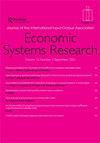使用交叉熵指标对投入产出表进行多层次比较
IF 1.6
4区 经济学
Q2 ECONOMICS
引用次数: 1
摘要
我们引入了一个交叉熵(CE)指标来量化两个输入输出表或两个基于输入输出分析结果的表之间的差异程度。我们的工作部署了CE指标的一个独特特征:它可以分解,允许在一个连贯的框架内进行不同级别的矩阵比较。为了说明这种方法的威力,我们将该技术应用于2011年的五个多地区输入-输出(MRIO)表,这些表来自Eora、EXIOBASE、GTAP、OECD和WIOD数据库。我们在MRIO之间以及基于这些MRIO的全球价值链(GVC)计算之间进行成对比较。我们发现,与更广泛的聚合相关的问题的答案通常非常相似,但单个行业层面的问题答案在不同的MRIO中可能截然不同。本文章由计算机程序翻译,如有差异,请以英文原文为准。
Multi-level comparisons of input–output tables using cross-entropy indicators
We introduce a cross-entropy (CE) indicator to quantify the extent to which two input–output tables or two tables with results based on input–output analysis differ from each other. Our work deploys a unique feature of the CE indicator: it can be decomposed, allowing for matrix comparisons at various levels within one coherent framework. To illustrate the power of this approach, we apply the technique to five multi-region input–output (MRIO) tables for 2011, derived from the Eora, EXIOBASE, GTAP, OECD and WIOD databases. We make pairwise comparisons between MRIOs and between global value chain (GVC) computations based on these MRIOs. We find that answers to questions related to broader aggregates are generally quite similar, but that answers to questions at the level of single industries can be rather different across MRIOs.
求助全文
通过发布文献求助,成功后即可免费获取论文全文。
去求助
来源期刊

Economic Systems Research
ECONOMICS-
CiteScore
5.60
自引率
4.00%
发文量
17
期刊介绍:
Economic Systems Research is a double blind peer-reviewed scientific journal dedicated to the furtherance of theoretical and factual knowledge about economic systems, structures and processes, and their change through time and space, at the subnational, national and international level. The journal contains sensible, matter-of-fact tools and data for modelling, policy analysis, planning and decision making in large economic environments. It promotes understanding in economic thinking and between theoretical schools of East and West, North and South.
 求助内容:
求助内容: 应助结果提醒方式:
应助结果提醒方式:


